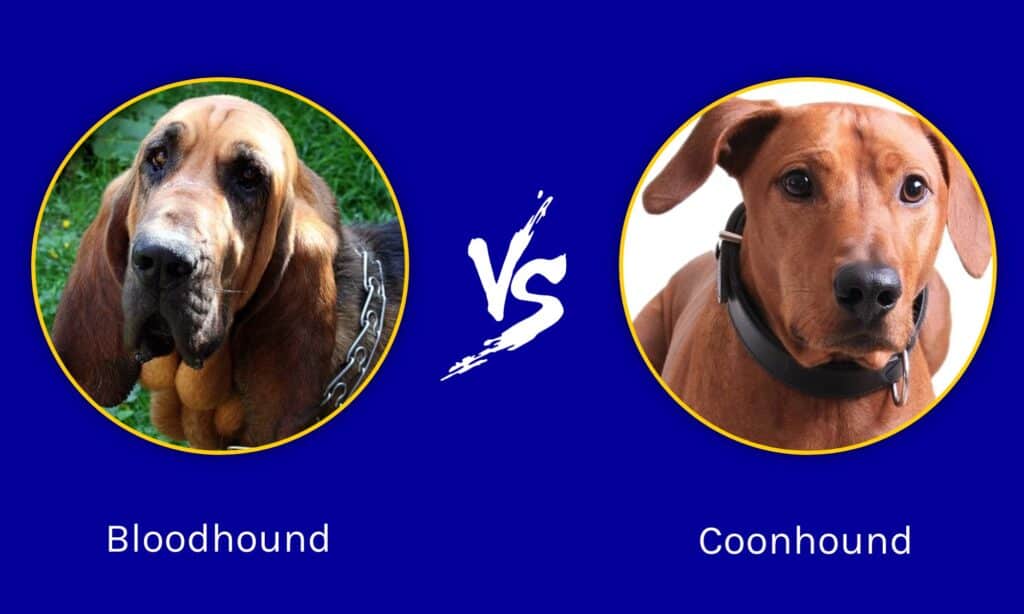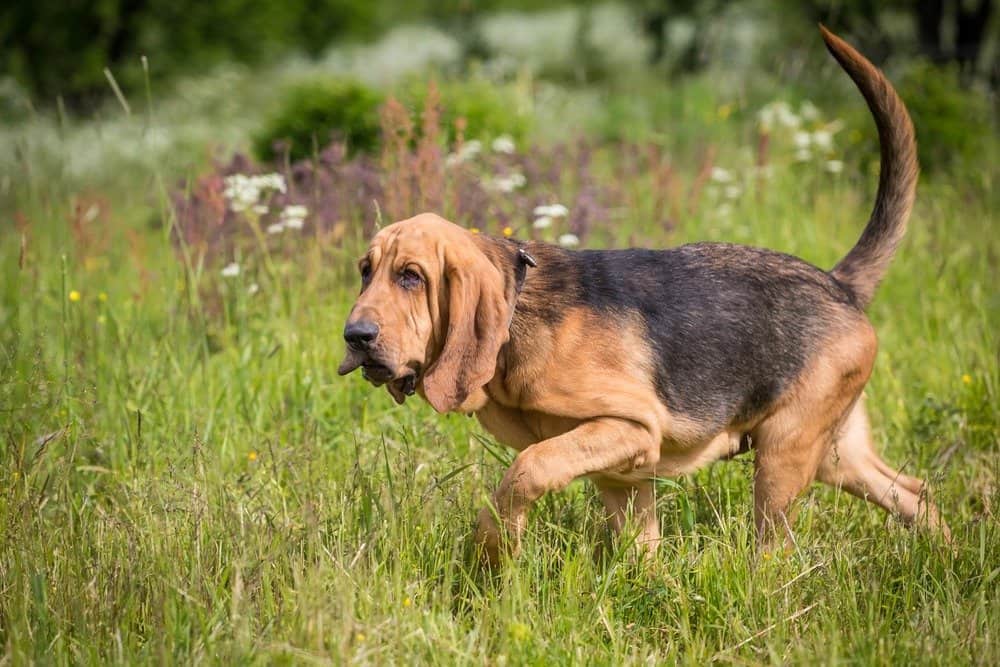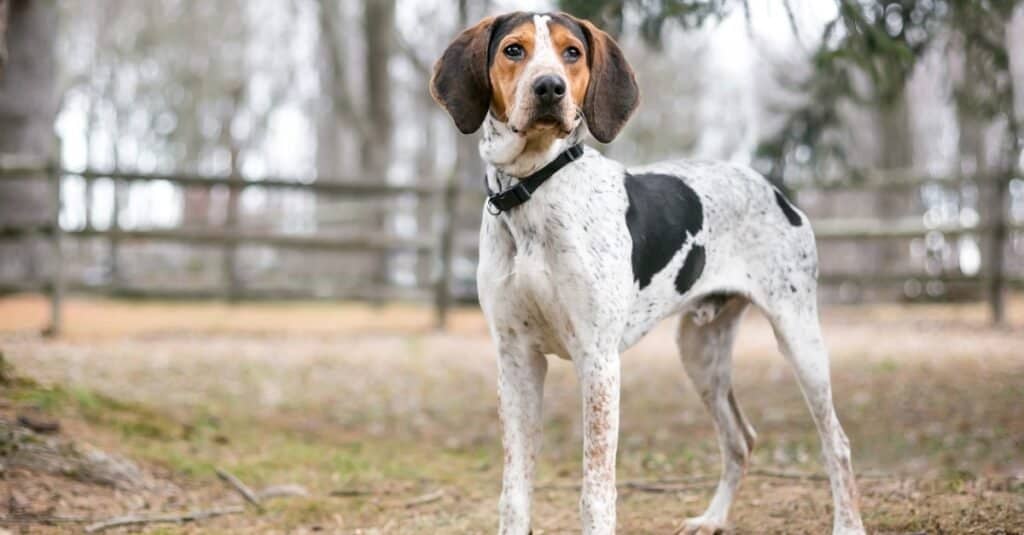Bloodhounds and coonhounds are both dogs with a good sense of smell and incredible tracking ability. Although they have a similar appearance which makes it easy for them to be mistaken, they are both unique and fascinating dogs. In fact, when it comes to bloodhound vs coonhound, there are quite a few differences that we can use to tell them apart.
This article will discuss the key differences between bloodhounds and coonhounds, including how big they are and what they look like. We’ll also learn about their temperaments and what these dogs are mainly used for. So join us as we discover everything you need to know about the differences between bloodhounds and coonhounds!
Comparing Bloodhound vs Coonhound

Both bloodhounds and coonhounds are scent hounds which means that they have an excellent sense of smell and can track that scent over many miles. However, bloodhounds are a specific breed of dogs, while coonhounds are a group of breeds. There are six different breeds of coonhound – black and tan coonhound, redbone coonhound, English coonhound, bluetick coonhound, treeing walker coonhound, and Plott hound. Although there are some variations between these different breeds of coonhounds, there are still some key differences that we can use to distinguish them from bloodhounds.
| Bloodhound | Coonhound | |
| Origin | Belgium | US |
| Size | Weight – 80 to 110 pounds Height – 22 to 27 inches | Weight – 40 to 75 pounds Height – 20 to 28 inches |
| Color | Black and tan, liver and tan, red | Black & tan, red, brindle, tricolor with white |
| Neck | Wrinkled | No wrinkles |
| Build | Heavy boned, sturdy, broad & deep chest, long ears, short muzzle, droopy lips with wrinkles | Proportionate body and chest, long ears, no wrinkles |
| Coat | Rough, hard to the touch | Short and dense |
| Temperament | Gentle, affectionate, intelligent | Affectionate, calm, intelligent, independent, can be stubborn |
| Uses | Tracking humans | Hunting raccoons, bobcats, mountain lions, bears |
| Lifespan | 7 – 12 years | 10 – 12 years |
The 5 Key Differences Between Bloodhounds and Coonhounds
The main differences between bloodhounds and coonhounds are size, color, build, and their main uses. Bloodhounds are much heavier than coonhounds and have a heavier build. They also have wrinkled skin on their neck while coonhounds don’t. However, coonhounds have a much wider variety of colors than bloodhounds which are limited to three colors. Although both have an excellent sense of smell, bloodhounds are mainly used for tracking missing people, while coonhounds are used for tracking animals.
Let’s discuss all of these differences in more detail below.
Bloodhound vs Coonhound: Size
Most bloodhounds weigh between 80 and 110 pounds and stand between 22 and 27 inches high at the shoulder. The size of coonhounds varies between the different breeds, but as a group, they weigh between 40 and 75 pounds and stand between 20 and 28 inches at the shoulder. Interestingly, Plott hounds can be slightly taller than bloodhounds with a maximum of 28 inches, but they are not the heaviest of the coonhounds. Black and tan coonhounds are the heaviest of the coonhounds, but even the largest of them are still lighter than bloodhounds.
Bloodhound vs Coonhound: Color
Originally, bloodhounds used to be much more varied in their coat color. However, nowadays, they are typically only black and tan, liver and tan, or red. White markings can sometimes be found on the feet or the chest but are not common.
The color of coonhounds varies depending on the breed, but typically they are black and tan, red, brindle, or tricolor (any of the mentioned colors with white). The English coonhound has the widest variety of color and can be lemon and white, black and white, red and white, tricolor, redtick, or bluetick.
Bloodhound vs Coonhound: Appearance

Bloodhounds have incredibly long ears and wrinkled necks.
©Edoma/Shutterstock.com
One of the most distinctive features of bloodhounds is their extraordinarily long, floppy ears that often hang below their face. They have noticeable wrinkles on their neck and a short muzzle droopy lips which also have a lot of wrinkles. Bloodhounds have a long and heavy-boned body which gives them a sturdy-looking appearance. Their chest is particularly broad and deep, which adds to this look.
Coonhounds also have long, floppy ears, which are shorter and more proportionate to the size of the face in most coonhound breeds. They also have a lighter-framed body that looks more proportional than a bloodhound. Coonhounds lack the wrinkles on their necks, and their lips are not as droopy.
Bloodhound vs Coonhound: Temperament
Both bloodhounds and coonhounds are great pets, as they are affectionate and loving towards their owners. Bloodhounds especially are gentle when they are not tracking a scent and make great family pets as they are tolerant of children and even of very young tots.
Coonhounds are also calm and gentle, but they can be independent and stubborn when they set their minds to it. They can sometimes be a little too independent to tolerate very young children. Coonhounds can be wary and reserved around strangers.
Bloodhound vs Coonhound: Uses

Coonhounds are used to hunt raccoons as they can even detect them in trees.
©Mary Swift/Shutterstock.com
Although both bloodhounds and coonhounds are scent hounds and have strong tracking instincts, their main uses are vastly different. Originally, bloodhounds were used for hunting deer and wild boar. However, due to their excellent tracking ability, they are now often used for tracking people and are regularly used by police and search teams to find missing people. Bloodhounds can pick up and follow scents that are days old because they have such a superior sense of smell.
The primary use of coonhounds is hunting raccoons, which is where they get their name from. They are also used for hunting other animals such as bobcats, mountain lions, and bears. Coonhounds were developed because foxhounds were incapable of maintaining the scent of animals that climbed trees and subsequently became confused. Therefore, the early dogs that were used to create coonhounds were chosen for their ability to detect animals that were in trees. However, despite their primary purpose being for hunting animals, with proper training, coonhounds are also perfectly capable of detecting humans just like bloodhounds do and are also often used by police.
The photo featured at the top of this post is © Pleple2000, CC BY-SA 3.0, via Wikimedia Commons – License / Original
Ready to discover the top 10 cutest dog breeds in the entire world?
How about the fastest dogs, the largest dogs and those that are -- quite frankly -- just the kindest dogs on the planet? Each day, AZ Animals sends out lists just like this to our thousands of email subscribers. And the best part? It's FREE. Join today by entering your email below.
FAQs (Frequently Asked Questions)
Do bloodhounds and coonhounds work in packs?
Coonhounds can work both individually and as a member of a pack. However, bloodhounds do not typically work as packs as each dog tends to like to pick up and follow a scent on their own.
Are coonhounds and bloodhounds related?
Yes, bloodhounds were bred with foxhounds and other hunting dogs to create the coonhound. Bloodhounds were specifically used to improve the tracking ability of them.
Where did bloodhounds originate from?
According to legend, bloodhounds are descended from the hounds that were kept by monks at the Saint-Hubert monastery in Belgium.
Thank you for reading! Have some feedback for us? Contact the AZ Animals editorial team.






